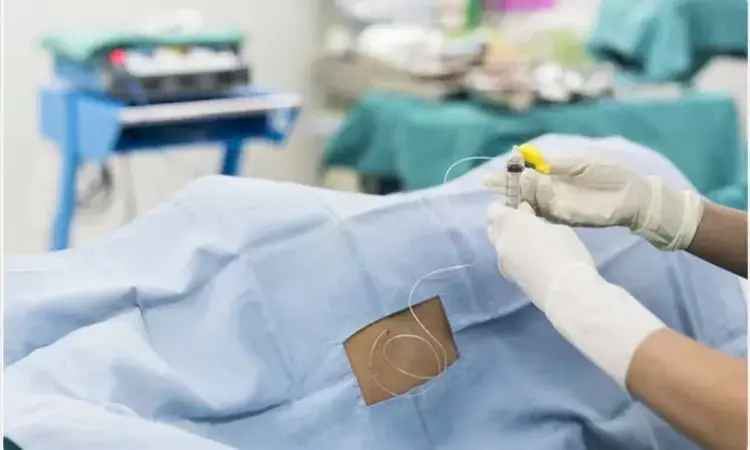- Home
- Medical news & Guidelines
- Anesthesiology
- Cardiology and CTVS
- Critical Care
- Dentistry
- Dermatology
- Diabetes and Endocrinology
- ENT
- Gastroenterology
- Medicine
- Nephrology
- Neurology
- Obstretics-Gynaecology
- Oncology
- Ophthalmology
- Orthopaedics
- Pediatrics-Neonatology
- Psychiatry
- Pulmonology
- Radiology
- Surgery
- Urology
- Laboratory Medicine
- Diet
- Nursing
- Paramedical
- Physiotherapy
- Health news
- Fact Check
- Bone Health Fact Check
- Brain Health Fact Check
- Cancer Related Fact Check
- Child Care Fact Check
- Dental and oral health fact check
- Diabetes and metabolic health fact check
- Diet and Nutrition Fact Check
- Eye and ENT Care Fact Check
- Fitness fact check
- Gut health fact check
- Heart health fact check
- Kidney health fact check
- Medical education fact check
- Men's health fact check
- Respiratory fact check
- Skin and hair care fact check
- Vaccine and Immunization fact check
- Women's health fact check
- AYUSH
- State News
- Andaman and Nicobar Islands
- Andhra Pradesh
- Arunachal Pradesh
- Assam
- Bihar
- Chandigarh
- Chattisgarh
- Dadra and Nagar Haveli
- Daman and Diu
- Delhi
- Goa
- Gujarat
- Haryana
- Himachal Pradesh
- Jammu & Kashmir
- Jharkhand
- Karnataka
- Kerala
- Ladakh
- Lakshadweep
- Madhya Pradesh
- Maharashtra
- Manipur
- Meghalaya
- Mizoram
- Nagaland
- Odisha
- Puducherry
- Punjab
- Rajasthan
- Sikkim
- Tamil Nadu
- Telangana
- Tripura
- Uttar Pradesh
- Uttrakhand
- West Bengal
- Medical Education
- Industry
Myofascial block provides significant pain relief during percutaneous nephrolithotomy

After spinal anaesthesia, opioids and nonsteroidal anti-inflammatory medications (NSAIDS) have long been the mainstays of postoperative pain treatment. However, from the perspective of the patient, their unpleasant side effects, including as gastritis, diarrhoea, nausea, and vomiting, have not proven beneficial. Myofascial blocks, one of the most recent developments in regional anaesthesia, have shown its effectiveness in lowering postoperative site pain without unpleasant side effects, particularly for abdominal and thoracic procedures. The removal of renal and ureteric calculi is accomplished by the minimally invasive procedure known as percutaneous nephrolithotomy (PCNL). Acute pain in the postoperative phase caused by cutaneous innervation at the incision site (T8-T11), renal parenchymal discomfort, and ureteric pain are some of the most frequent consequences of this treatment (T10–L2). Recent research has revealed that erector spinae plane block (ESPB), compared to traditional analgesia with tramadol in PCNL, lowered VAS score, provided acceptable postoperative analgesia, and had comparable haemodynamic alterations and side effects.
Sixty American Society of Anesthesiologists physical status I and II patients scheduled for PCNL under spinal anaesthesia participated in this prospective randomised research. They were randomly divided into two groups of 30 patients each. Following PCNL, group A got ESPB at T8 level along with 20 ml of injection bupivacaine 0.25% and dexamethasone 8 mg, while group B received injection tramadol 1.5 mg/kg intravenously. Visual analogue scale (VAS) score comparison was the main endpoint in the first 24 hours postoperatively, with hemodynamic factors and the need for rescue analgesia as secondary goals. When compared to group B, which had a mean VAS score of 6.61 0.50 at 6 hours, group A (ESPBmean )'s VAS score of 3.15 0.68 was relatively low. After 4 hours postoperatively, VAS scores were still higher, and a significant percentage of group B patients needed rescue analgesics.
In this research, ESPB and traditional tramadol usage as a method of postoperative analgesia after PCNL were compared. With identical haemodynamic characteristics, ESPB demonstrated a considerable decrease in the VAS ratings and the need for rescue analgesia. The application range for ultrasound-guided ESPB is very broad. It inhibits the ramus dorsalis of the thoracic and abdominal spinal neurons. In our trial, the overall tramadol required was lower and the mean duration to first rescue analgesia was 12 hours. The ESPB group only needed one dosage of a rescue analgesic, compared to the control group's average of 3–4 doses. The extent of the discomfort is between T8 and T12 since the incision location is between T10 and T11. Given the results of the research, it seems that administering the block at T8 is sufficient for providing adequate analgesia. Comparing ESPB to the standard use of analgesia with tramadol in PCNL, which resulted in comparable haemodynamic alterations and negative consequences, the former lowered VAS score and the latter provided appropriate postoperative analgesia.
Reference –
Shah, Bhavini; Cherukuri, Kaushik; Tudimilla, Sonalika; Shah, Krusha Suresh. Erector spinae plane block for postoperative analgesia following percutaneous nephrolithotomy under spinal anaesthesia- A randomised controlled study. Indian Journal of Anaesthesia 66(12):p 837-841, December 2022. | DOI: 10.4103/ija.ija_692_21
MBBS, MD (Anaesthesiology), FNB (Cardiac Anaesthesiology)
Dr Monish Raut is a practicing Cardiac Anesthesiologist. He completed his MBBS at Government Medical College, Nagpur, and pursued his MD in Anesthesiology at BJ Medical College, Pune. Further specializing in Cardiac Anesthesiology, Dr Raut earned his FNB in Cardiac Anesthesiology from Sir Ganga Ram Hospital, Delhi.
Dr Kamal Kant Kohli-MBBS, DTCD- a chest specialist with more than 30 years of practice and a flair for writing clinical articles, Dr Kamal Kant Kohli joined Medical Dialogues as a Chief Editor of Medical News. Besides writing articles, as an editor, he proofreads and verifies all the medical content published on Medical Dialogues including those coming from journals, studies,medical conferences,guidelines etc. Email: drkohli@medicaldialogues.in. Contact no. 011-43720751


